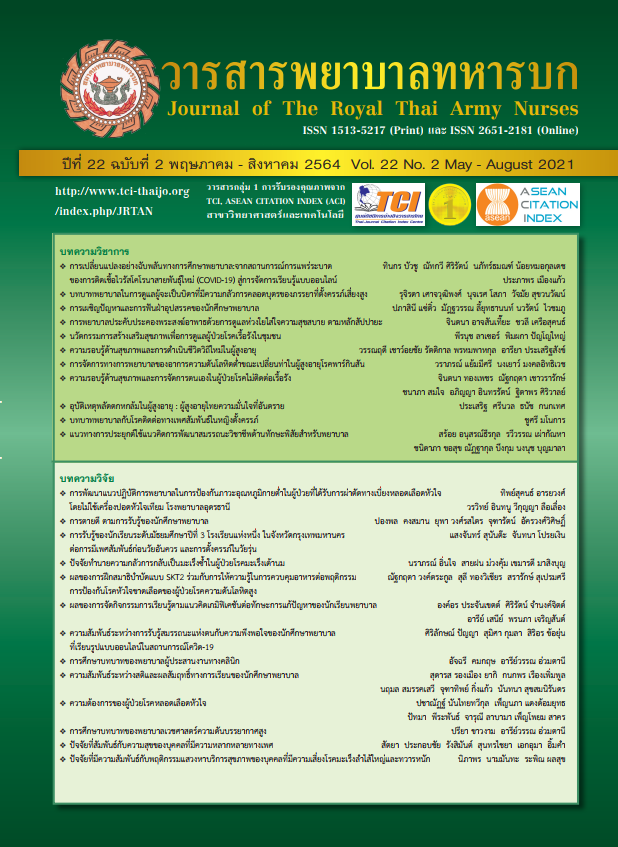Pain and Pain Management in Cesarean Section under General Anesthesia
Keywords:
pain, pain management, cesarean section, general anesthesiaAbstract
This descriptive research aimed to explore post-operation pain, pain management methods, and satisfaction in pain management among patients who have cesarean sections performed under general anesthesia. Symptom management was used as the conceptual framework by using the Symptom Management Model by Dodd and colleague. The sample consisted of patients admitted to a ward at Thasala Hospital, Nakhon Si Thammarat Province. Research participants were recruited by the purposive sampling method. A total of 100 patients were surveyed. Data were collected via a demographics questionnaire, the pain management questionnaire developed by the researcher based on a literature review, the pain assessment (NRS) questionnaire was used to assess the pain management of patients in 24, 48, and 72 hours, as well as the patient satisfaction questionnaire. Data were analyzed by descriptive statistics and the Friedman with Dunn-Bonferroni post hoc test.
Results indicated that the mean pain level of post-operative patients was high at 24 and 48 hours and lower at 72 hours after surgery ( = 8.3 SD 1.66,
= 5.52 SD = 1.51,
= 3.71 SD = 1.97), respectively. The difference was statistically significant (χ2 = 268.89 p <.01). The pain management in the first 24 hours of a post-operative patient was resting at 75%. The effect of postoperative pain in the first 24 hours was sitting down at 7%. So in the first 24 hours, 75% of patients were prescribed bed rest to manage their pain and for 7%. Patients had a high level of satisfaction in pain management both in the recovery room and in the hospital ward at 77%, and 81% respectively.
Downloads
References
Diejomaoh MF, Al-Jassar W, Bello Z, Karunakaran K, Mohammed A. The Relevance of the Second Cesarean Delivery in the Reduction of Institutional Cesarean Delivery Rates. Medical Principles and Practice. 2018; 27(6): 555-61.
Yukaew N. Cesarean section rate according to Robson’s classification. J Prev Med Assoc Thai 2017; 7: 262-71.
Uakritdathikarn T. Perioperative morbidity and mortality and neonatal outcomes in patients undergoing cesarean section with spinal anesthesia versus general anesthesia in Vachira Phuket hospital. Region 11 Med J. 2017; 31(1): 15-26.
Kintu A, Abdulla S, Lubikire A, Nabukenya MT, Igaga E, Bulamba F, Semakula D, Olufolabi AJ. Postoperative pain after cesarean section: assessment and management in a tertiary hospital in a low-income country. BMC health services research. 2019; 19(1): 1-6.
Sumikura H, Niwa H, Sato M, Nakamoto T, Asai T, Hagihira S. Rethinking general anesthesia for esarean section. Journal of anesthesia. 2016; 30(2): 268-73.
Dodd M, Janson S, Facione N, Faucett J, Froelicher ES, Humphreys J, Lee K, Miaskowski C, Puntillo K, Rankin S, Taylor D. Advancing the science of symptom management. Journal of advanced nursing. 2001; 33(5): 668-76.
Cohen, J. Statistical power analysis for the behavioral sciences. New York: Academic Press. 1977.
Liu TT, Raju A, Boesel T, Cyna AM, Tan SG. Chronic pain after caesarean delivery: An Australian cohort. Anaesthesia and Intensive care. 2013; 41(4): 496-500.
Borges NC, Silva BC, Pedroso CF, Silva TC, Tatagiba BS, Pereira LV. Dolor postoperatorio en mujeres sometidas a cesárea. Enfermería Global. 2017; 16(48): 354-83.
Cançado TO, Omais M, Ashmawi HA, Torres ML. Dor crônica pós-cesariana. Influência da técnica anestésico-cirúrgica e da analgesia pós-operatória. Revista Brasileira de Anestesiologia. 2012; 62(6): 768-74.
Sutton, C., & Carvalho, B. Optimal Pain Management After Cesarean Delivery. Anesthesiology Clinics. 2016; 35(1): 107-124.
Ituk U, Habib AS. Enhanced recovery after cesarean delivery. F1000Research. 2018;7.
Pinchaleaw, D, Bhoosahan. Factors Related to Women’ s Distress after Cesarean Section. Journal of The Royal Thai Army Nurses. 2015; 16(1): 101-108. (In Thai)
Masigati HG, Chilonga KS. Postoperative pain management outcomes among adults treated at a tertiary hospital in Moshi, Tanzania. Tanzania journal of health research. 2014; 16(1): 47-53.
Ismail S, Afshan G, Monem A, Ahmed A. Postoperative analgesia following caesarean section: intravenous patient controlled analgesia versus conventional continuous infusion. Open Journal of Anesthesiology. 2012; 2(4): 120-6.
Wongsiri P. Effects of Pain Management Program Toward Release Pain, Anxiety and Satisfaction Receiving General Anesthesia for Women’s Cesarean Section, Recovery Room, Suratthani Hospital. Region 11 Med J. 11. 2019; 33(3): 441-60.
Ismail S, Shahzad K, Shafiq F. Observational study to assess the effectiveness of postoperative pain management of patients undergoing elective cesarean section. Journal of anaesthesiology, clinical pharmacology. 2012; 28(1): 36-40.
Downloads
Published
How to Cite
Issue
Section
License
บทความหรือข้อคิดเห็นใดใดที่ปรากฏในวารสารพยาบาลทหารบกเป็นวรรณกรรมของผู้เขียน ซึ่งบรรณาธิการหรือสมาคมพยาบาลทหารบก ไม่จำเป็นต้องเห็นด้วย
บทความที่ได้รับการตีพิมพ์เป็นลิขสิทธิ์ของวารสารพยาบาลทหารบก
The ideas and opinions expressed in the Journal of The Royal Thai Army Nurses are those of the authors and not necessarily those
of the editor or Royal Thai Army Nurses Association.






